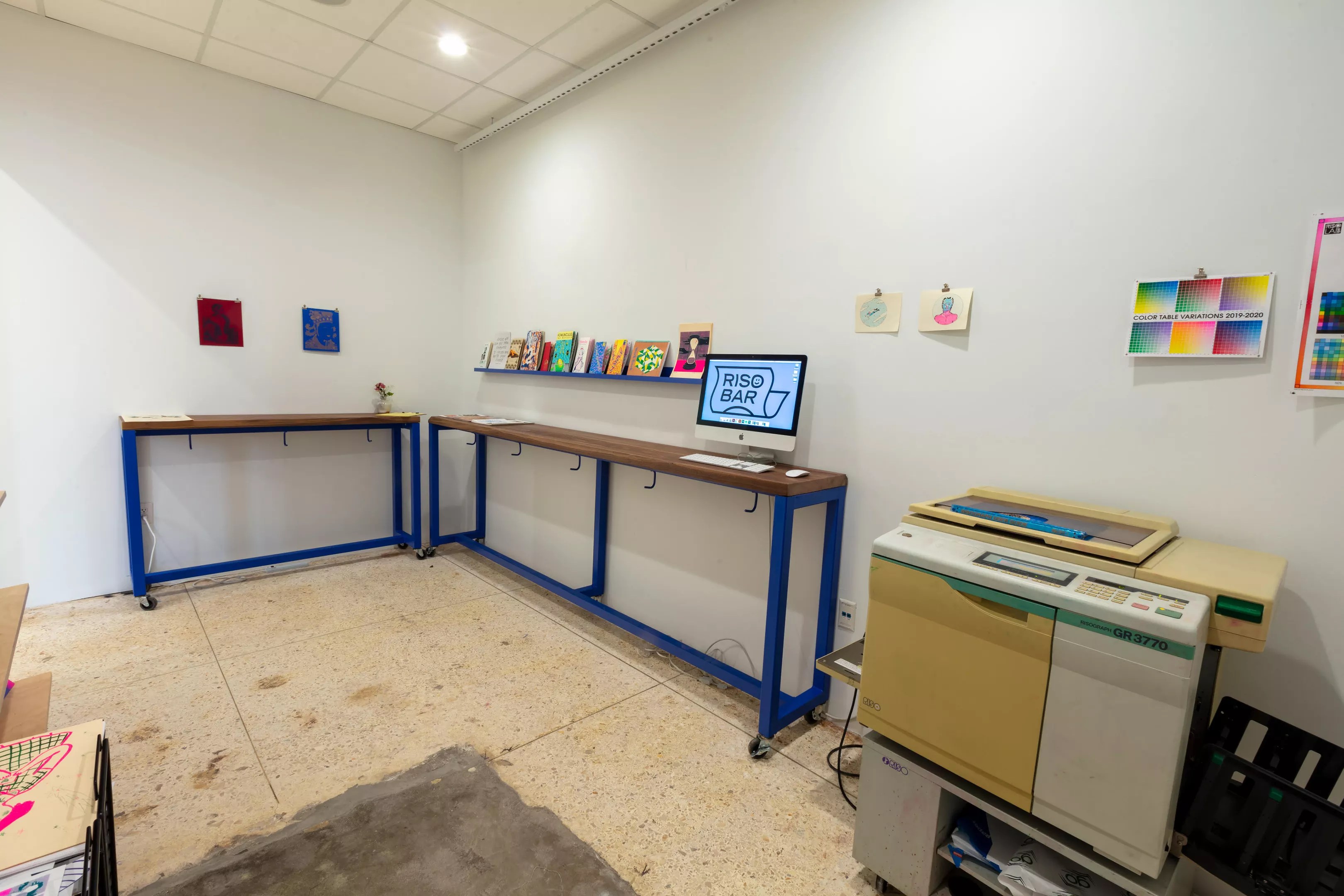
Kevin Todora

Audio By Carbonatix
When they first gained popularity in the 1980s, RISO (risography) printing machines were often used for simple, text-based printing such as tracts and other pamphlets intended to be mass-produced and mass-dispersed. This is why many months ago, before the RISO Bar exhibition was erected at Southern Methodist University’s Pollock Gallery, co-founders Finn Jubak and May Makki could be found poking around sundry North Texas churches in search of retired RISO machines.
“The only church that had one actually donated their last to a school the week before we called,” says Makki, who’s an artist in her own right.
Fortunately, a few new RISO-enthusiast friends stepped in around the time of the pair’s hundredth call to contribute two risograph machines of their own, and from there the exhibition, now a collective, found its footing. It has since become Dallas’ first and only RISO printing-press-come-cooperative space “interested in experimental approaches to risograph printing and cooperative learning,” as described by Makki.
There are several idiosyncrasies to the risograph machine that justify why it’s in demand with organizations such as RISO BAR, starting with the ink used in the process. Risograph ink is largely soy-based, which means that it’s friendlier to the environment and significantly cheaper than the often additive-filled ink used in other printers.
The ink comes in a big, cylindrical container that is inserted into the RISO printer and used to print a single color onto a “master” stencil. The master is created by burning an image into a thermally sensitive paper, which is then filled with tiny holes denoting where the ink should transfer onto the paper. The paper on which the image transfers is rough, to ensure the ink adheres, and must run through the risograph more than once in order to achieve multiple colors. This makes the process rather delicate, and the final product perfectly imperfect.
Before the pandemic, RISO BAR was set to hold space at the SMU Pollock Gallery for 12 months. In addition to a gallery, they functioned as a library and all-round collaborative space, open for the public’s interactive pleasure. Although the coronavirus-related closure was difficult for the collective as a whole, the move to an online model has kept community interaction consistently fruitful.
“We were feeling so isolated, especially at the beginning of COVID, and wanted to find a way to share resources and feel connected again … The idea was to draw on our collective knowledge as a source of strength.” RISO BAR’s Finn Jubak
“Our task for the remainder of the exhibition at the Pollock Gallery is to workshop our business model to ensure we are sustainable beyond SMU’s walls,” says Makki. “Right now, we are especially excited about opportunities to collaborate with other organizations and collectives in Dallas.” Namely, Deep Vellum Books, which hosted a virtual Q&A with the collective to discuss “Printing, Bookmaking and Protest” in light of RISO BAR’s involvement in the Black Lives Matter protests around Dallas.
The remains of protests past are often left behind in their iconography. In the past few months, as Dallasites marched in defense of Black lives, RISO BAR’s signs were handed out by the hundreds and seen flying high above the heads of both young and old amidst the crowds.
Elizabeth Han, the artist behind the idea, had recently curated ME^2, a “critical analysis” of meme culture, which highlighted the linguistic influence memes hold over present generations.
“I was thinking a lot about how the power of a successful meme comes from repetition,” said Han in an email. “… One of the great advantages to risograph printing is that once you set up an image, it’s just as easy to print one copy as it is 100. Mylan [Nguyen] designed a beautiful illustration, and I printed several hundred copies to bring to each protest I attended.”
Another example of the ways in which the risograph’s expedience can be conducive to serving the community is through their recently printed Survival School, a series of how-to guides written and illustrated by Dallas locals, “compiling knowledge” (as per their Instagram) for everyday tasks.
“We were feeling so isolated, especially at the beginning of COVID, and wanted to find a way to share resources and feel connected again,” said RISO BAR’s Jubak in an email. “The idea was to draw on our collective knowledge as a source of strength.”
Some examples of these pamphlets include “How To Make A Face Mask Out of Bedsheets,” “How to Change a Tire” and “How to ‘Catch Up’ With a Friend Over the Phone During a Pandemic.” The project was supported by Ignite Arts Dallas, one of RISO BAR’s many collaborators and longtime champion of grassroots artistic endeavors across North Texas. RISO BAR has grown into something of a local arts champion in itself. Its most recent initiative, Artists For Public Relief, was an online store devoted to selling local artists’ limited-edition prints to raise funds for BYP100, The Black Trans Advocacy Coalition, and Mothers Against Police Brutality.
The word “riso” itself ironically translates to “ideal” which, from an artists’ view could be considered a challenge. No image printed with a risograph is ideal in the conventional sense, nor is the process. In addition to Han, Jubak and Makki, RISO BAR is composed of Sofía Bastidas, Harris Chowdhary, Sophia Haid, Mylan Nguyen, and Taro Waggoner. The group has transcended this meaning by upholding a community ideal, revolving around the risograph.
In a time of unexpected distance from others and a heightened awareness of touch (even on hard surfaces), the beauty of risograph print is in its physical tactility, as the images on the page never seem too far away from the hands that produced them.